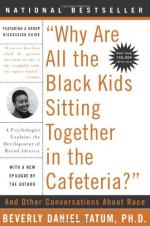
|
| Name: _________________________ | Period: ___________________ |
This test consists of 15 multiple choice questions and 5 short answer questions.
Multiple Choice Questions
1. Tatum claims that the idea that biracial children suffer in a particular way during childhood is what in Part IV, Beyond Black and White, Chapter 9, Identity Development in Multiracial Families?
(a) Well established.
(b) A lie based on superiority.
(c) Proven.
(d) A misconception.
2. When did the Virginia General Assembly pass "The Racial Integrity Act" and "The Sterilization Act"?
(a) 1911.
(b) 1953.
(c) 1924.
(d) 1879.
3. What is the first of three stages of racial consciousness in minority groups delineated in Jean Phinney's model of ethnic identity development?
(a) Unexamined.
(b) Achievement.
(c) Searching.
(d) Abandonment.
4. What is the second factor the author describes for why process-oriented affirmative action is often ineffective in Part III, Understanding Whiteness in a White Context, Chapter 7, White Identity and Affirmative Action?
(a) It leaves open too many opportunities for bias.
(b) It opens the door to racism.
(c) It opens the door to reverse racism.
(d) It creates a dichotomy.
5. In societies that regard some races of people as dominant, what refers to the automatic assignment of children of a mixed union groups to the subordinate group?
(a) Hypodescent.
(b) Discrimination.
(c) Marginalization.
(d) Familism.
6. What refers to a disparity or relative inadequacy in natural endowments?
(a) Inequality.
(b) Martyr.
(c) Moratorium.
(d) Hostility.
7. What refers to state and local laws in the United States enacted between 1876 and 1965 that mandated racial segregation in all public facilities?
(a) Jim Crow laws.
(b) Colored laws.
(c) White suprmecist laws.
(d) Segregation laws.
8. What refers to a person who is put to death or endures great suffering on behalf of any belief, principle, or cause?
(a) Stereotype.
(b) Martyr.
(c) Raceless.
(d) Victim.
9. The revised OMB standards since 1997 identify a minimum of how many racial categories?
(a) 18.
(b) 8.
(c) 12.
(d) 5.
10. Barack Obama's mother is from __________.
(a) Ontario.
(b) Mexico.
(c) Kansas.
(d) Georgia.
11. What is the second largest community of color that is growing the fastest according to the author?
(a) Native American.
(b) Latino.
(c) Arab.
(d) Asian-Pacific American.
12. To avoid accusations about reverse discrimination for goal-oriented affirmative action it is imperative to establish in advance clear and meaningful what, according to the author?
(a) Selection criteria.
(b) Immersion.
(c) Bias.
(d) Prejudice.
13. When was Executive Order 11246 enacted, which required federal contractors to take "affirmative action" to hire without regard to race, religion and national origin?
(a) 1969.
(b) 1979.
(c) 1973.
(d) 1965.
14. Tatum claims that one thing affirmative action is NOT is what in Part III, Understanding Whiteness in a White Context, Chapter 7, White Identity and Affirmative Action?
(a) Familism.
(b) Egalitarian.
(c) Quotas.
(d) Linear.
15. Process-oriented conceptions of affirmative action try to formulate an ideally fair application process that is what?
(a) Heterogeneous.
(b) Racially blind.
(c) Goal-oriented.
(d) Racialy biased.
Short Answer Questions
1. Tatum describes the ethic group of Asians, including Pacific Islanders, East Asians, Southeast Asians and South Asians as comprising how many people?
2. According to the author in Part III, Understanding Whiteness in a White Context, Chapter 6, The Development of White Identity, whites are initially unaware how the internalization and socialization of what has affected them?
3. What is a system in which descent is traced through the mother and maternal ancestors?
4. What is the second of three stages of racial consciousness in minority groups delineated in Jean Phinney's model of ethnic identity development?
5. Tatum writes in Part III, Understanding Whiteness in a White Context, Chapter 7, White Identity and Affirmative Action, that only when Whites understand what can they understand the rationale for affirmative action?
|
This section contains 537 words (approx. 2 pages at 300 words per page) |

|




